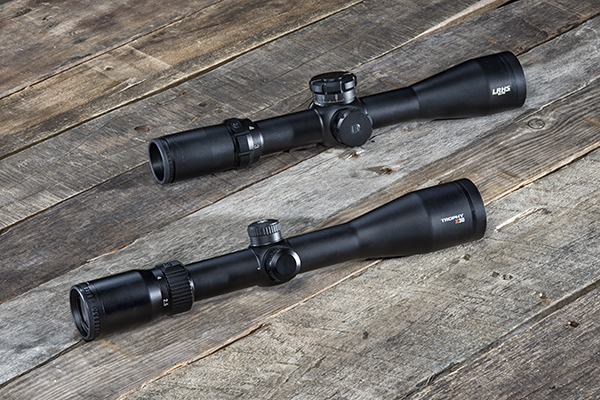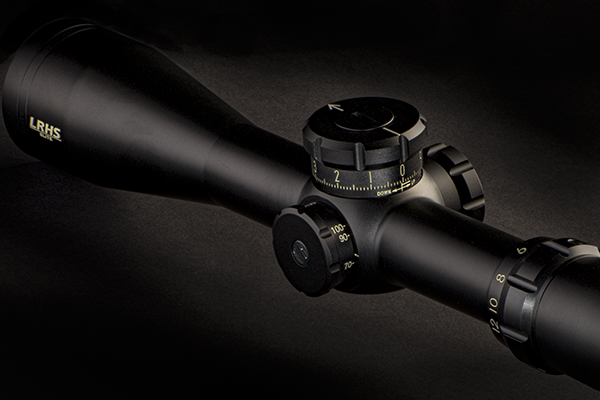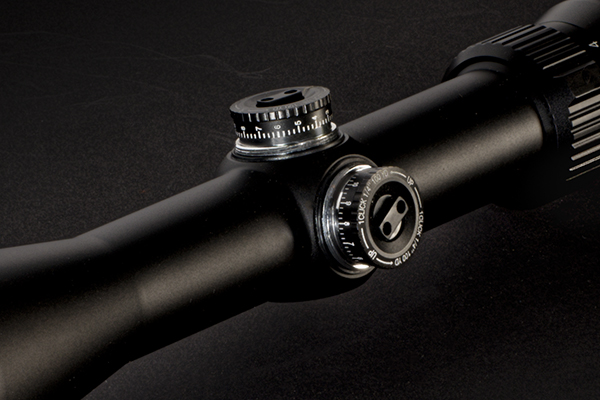S
SHOOTER13
Guest
So you’ve bought your firearm, you’ve saved up to buy a scope; you walk into a retail store and you start looking at options. The shop employee says “what kind of scope are you looking for?” and you’re not sure of how to reply! What’s out there? Each scope has a bunch of numbers on the box. What does it all mean ?
Fear not. We’ve all been there, and we’ve been just as confused. That’s why we’re here to help. There are a few important parts to know about when it comes to choosing scopes. Here’s a quick rundown.
Scope Basics
The scope consists of a body, or tube, containing several pieces of glass. These provide your view through the scope as well as your magnification. Some scopes will have fixed magnification while others will be adjustable. On the surface of one of the pieces of glass inside the scope is the reticle. You will see a crosshair, and in some scopes, integrated into this crosshair, you will see a series of dashes or dots going up and down, left and right. The final pieces of the scope you should know about are the turrets. They’re the knobs on the top and the side of the scope. You’ll use these to adjust the scope’s reticle up or down and left or right so that it coincides with where your gun is shooting.

The Reticle and Turrets
Now that you know the parts of a scope and what they do, here comes the tricky part. There are two systems of measurement that scope makers use when designing reticles and turrets: mils or MOA. A typical adjustment of 1 click on a mil based turret represents one-tenth of a mil (more on this to come). A typical adjustment on an MOA based turret represents 1/4 MOA (more on this to come). So, what are mils and MOA ?

Mils
“Mils” stands for milliradians. It does not mean “military”, though that is a common misconception. A milliradian is a measurement of an angle within a circle. To understand how a milliradian is measured, some trigonometry is required, but that is beyond the scope of this article. When looking through a mil based scope you will see either series of dots or hash marks on either side of the vertical and horizontal crosshairs.
What you really need to know about mils is this: when looking through your scope, you’ll see your crosshairs, as well as those dots or hash marks. At 100 yards, which is a common distance that is used for sighting in a hunting rifle, the distance between these dots represents a height of 3.6 inches on your target. As the distance to your target increases or decreases, so does the representative distance between your mil-dots or hash marks.
A quick word on adjusting your scope while sighting it in. If you are shooting at a target 100 yards away, and the bullet is striking the target centered left-to-right but impacts at the first dot above the crosshairs top-to-bottom, you’re hitting your target 3.6 inches high. You’ll need to know how much of an adjustment is made to the crosshairs when turning the dial on your turret. Most modern mil-based scopes adjust in 0.1 mil increments, meaning you will need to bring your crosshairs down 10 clicks of the wheel to hit dead center on your target.
MOA
MOA stands for “minute of angle.” A minute of angle is also a measurement of an angle within a circle, just as milliradians are. However, they differ in size, with mils being the larger of the two. Minutes of angle are a bit easier to understand than mils though; minutes are just a smaller measurement of a degree. Just like an hour, a degree is made up of 60 minutes.
When looking through your MOA scope, you’ll typically see your crosshairs, along with lines or dashes on both the vertical and horizontal axis. Using the previous example of 100 yards, the distance between these dashes represents a height of 1.047 inches on your target. While there is a standard known as S-MOA where that value is a true 1 inch between dashes, 1.047 inches is so close to 1 inch that it can just be rounded down.
For this example, we’re sighting our rifle in at 100 yards, and are hitting the target dead on top-to-bottom, but are hitting at the first dash on the left of the crosshairs. This means we’re off by 1 inch, making this an easy adjustment. Just as with a mil-dot scope, you’ll need to know how far each adjustment of the wheel on your turret moves your crosshairs. Modern scopes adjust in 1/4 MOA increments, meaning you will need to bring your crosshairs right 4 clicks of the wheel to hit dead-center on your target.

This TROPHY Xtreme scope features a MOA based turret with 1/4 adjustments.
Which One’s For You ?
There are several options to choose from; a mil reticle with mil turrets, an MOA reticle with MOA turrets, and a mil reticle with MOA turrets. Some want a matched system so they never have to convert between the two. Speaking of which, you’ll need to do a bit of math to convert between the two measurements, but it’s not too difficult. The only new thing you’ll need to know is that 1 mil is equal to 3.438 MOA.
Let’s say that our imaginary scope uses a mil-dot reticle, but the turret adjustments are made in 1-MOA increments. Once again shooting at 100 yards, if you’re off your target by 1 mil-dot in any direction, your adjustment will need to be 1 mil, or 3.438 MOA. With our 1-MOA adjusting turret, you’ll need to adjust 3-4 clicks in the appropriate direction. As you can understand, these adjustments aren’t ideal, but this should put you within ½ inch of where you want to be.
Which is better ? Neither, or both. It’s all about personal preference. The best way to know what you like is to try both. This doesn’t mean buying two scopes and then being stuck with the one that you didn’t like. Some professional scope manufacturers offer the same model with different reticle and click-value adjustments. If you’re a long-range hunter, the Bushnell Elite Long Range Hunter scope offers the option of a mil based reticle with mil adjustments or and MOA based reticle with MOA adjustments. If you’re a shorter range shooter used to looking at crosshair reticles, or just want a more affordable price range, you could start with Bushnell’s Legend Ultra HD 3-9x 50mm. It features a Multi-X crosshair reticle with a ¼-MOA click value and offers incredible low-light capability.
Although the focus of this article has been on rifles up until this point, it’s important to note that there are many scopes available for handguns as well. When shooting or hunting with a handgun you’ll want a lightweight-but-durable scope. At just 8 ounces, the Bushnell Trophy 2-6×32 Handgun Scope is a compact powerhouse available in a mil-dot reticle, as well as other configurations.
The number one piece of advice we can give you is to make sure you don’t forget about the importance of your scope mounting gear. You can buy the most precise scope and spend the time zeroing it in perfectly, but if your mount accessories are not reliable you’re going to lose that accuracy real quick. Look for a mount ring made of solid metal that will hold up to airline travel and rough days on the mountain. Weaver’s Grand Slam Rings are made in the U.S.A and will grip your scope and lock it in place. For tactical shooting we use the Weaver Six Hole Tactical-Style Rings, which have two extra holes and are made of aircraft grade aluminum.
Get Out There !!
My recommendation is to join a local shooting range or club and take lessons from a certified instructor. See what other shooters are using and ask them questions. When you get out there you will be presented with many opportunities to try various types of equipment, including both mil-dot and MOA scopes. Most shooters I know are happy to share what they know as well as what they own. But most importantly, have fun. It’s why we do what we do !!
Guns & Ammo Magazine: Shoot 101...by Courtney Nicolson
** NOTE: All of the scopes shown above are sponsored by paid advertisers...thus recommendations can be biased...YMMV **
Fear not. We’ve all been there, and we’ve been just as confused. That’s why we’re here to help. There are a few important parts to know about when it comes to choosing scopes. Here’s a quick rundown.
Scope Basics
The scope consists of a body, or tube, containing several pieces of glass. These provide your view through the scope as well as your magnification. Some scopes will have fixed magnification while others will be adjustable. On the surface of one of the pieces of glass inside the scope is the reticle. You will see a crosshair, and in some scopes, integrated into this crosshair, you will see a series of dashes or dots going up and down, left and right. The final pieces of the scope you should know about are the turrets. They’re the knobs on the top and the side of the scope. You’ll use these to adjust the scope’s reticle up or down and left or right so that it coincides with where your gun is shooting.

The Reticle and Turrets
Now that you know the parts of a scope and what they do, here comes the tricky part. There are two systems of measurement that scope makers use when designing reticles and turrets: mils or MOA. A typical adjustment of 1 click on a mil based turret represents one-tenth of a mil (more on this to come). A typical adjustment on an MOA based turret represents 1/4 MOA (more on this to come). So, what are mils and MOA ?

Mils
“Mils” stands for milliradians. It does not mean “military”, though that is a common misconception. A milliradian is a measurement of an angle within a circle. To understand how a milliradian is measured, some trigonometry is required, but that is beyond the scope of this article. When looking through a mil based scope you will see either series of dots or hash marks on either side of the vertical and horizontal crosshairs.
What you really need to know about mils is this: when looking through your scope, you’ll see your crosshairs, as well as those dots or hash marks. At 100 yards, which is a common distance that is used for sighting in a hunting rifle, the distance between these dots represents a height of 3.6 inches on your target. As the distance to your target increases or decreases, so does the representative distance between your mil-dots or hash marks.
A quick word on adjusting your scope while sighting it in. If you are shooting at a target 100 yards away, and the bullet is striking the target centered left-to-right but impacts at the first dot above the crosshairs top-to-bottom, you’re hitting your target 3.6 inches high. You’ll need to know how much of an adjustment is made to the crosshairs when turning the dial on your turret. Most modern mil-based scopes adjust in 0.1 mil increments, meaning you will need to bring your crosshairs down 10 clicks of the wheel to hit dead center on your target.
MOA
MOA stands for “minute of angle.” A minute of angle is also a measurement of an angle within a circle, just as milliradians are. However, they differ in size, with mils being the larger of the two. Minutes of angle are a bit easier to understand than mils though; minutes are just a smaller measurement of a degree. Just like an hour, a degree is made up of 60 minutes.
When looking through your MOA scope, you’ll typically see your crosshairs, along with lines or dashes on both the vertical and horizontal axis. Using the previous example of 100 yards, the distance between these dashes represents a height of 1.047 inches on your target. While there is a standard known as S-MOA where that value is a true 1 inch between dashes, 1.047 inches is so close to 1 inch that it can just be rounded down.
For this example, we’re sighting our rifle in at 100 yards, and are hitting the target dead on top-to-bottom, but are hitting at the first dash on the left of the crosshairs. This means we’re off by 1 inch, making this an easy adjustment. Just as with a mil-dot scope, you’ll need to know how far each adjustment of the wheel on your turret moves your crosshairs. Modern scopes adjust in 1/4 MOA increments, meaning you will need to bring your crosshairs right 4 clicks of the wheel to hit dead-center on your target.

This TROPHY Xtreme scope features a MOA based turret with 1/4 adjustments.
Which One’s For You ?
There are several options to choose from; a mil reticle with mil turrets, an MOA reticle with MOA turrets, and a mil reticle with MOA turrets. Some want a matched system so they never have to convert between the two. Speaking of which, you’ll need to do a bit of math to convert between the two measurements, but it’s not too difficult. The only new thing you’ll need to know is that 1 mil is equal to 3.438 MOA.
Let’s say that our imaginary scope uses a mil-dot reticle, but the turret adjustments are made in 1-MOA increments. Once again shooting at 100 yards, if you’re off your target by 1 mil-dot in any direction, your adjustment will need to be 1 mil, or 3.438 MOA. With our 1-MOA adjusting turret, you’ll need to adjust 3-4 clicks in the appropriate direction. As you can understand, these adjustments aren’t ideal, but this should put you within ½ inch of where you want to be.
Which is better ? Neither, or both. It’s all about personal preference. The best way to know what you like is to try both. This doesn’t mean buying two scopes and then being stuck with the one that you didn’t like. Some professional scope manufacturers offer the same model with different reticle and click-value adjustments. If you’re a long-range hunter, the Bushnell Elite Long Range Hunter scope offers the option of a mil based reticle with mil adjustments or and MOA based reticle with MOA adjustments. If you’re a shorter range shooter used to looking at crosshair reticles, or just want a more affordable price range, you could start with Bushnell’s Legend Ultra HD 3-9x 50mm. It features a Multi-X crosshair reticle with a ¼-MOA click value and offers incredible low-light capability.
Although the focus of this article has been on rifles up until this point, it’s important to note that there are many scopes available for handguns as well. When shooting or hunting with a handgun you’ll want a lightweight-but-durable scope. At just 8 ounces, the Bushnell Trophy 2-6×32 Handgun Scope is a compact powerhouse available in a mil-dot reticle, as well as other configurations.
The number one piece of advice we can give you is to make sure you don’t forget about the importance of your scope mounting gear. You can buy the most precise scope and spend the time zeroing it in perfectly, but if your mount accessories are not reliable you’re going to lose that accuracy real quick. Look for a mount ring made of solid metal that will hold up to airline travel and rough days on the mountain. Weaver’s Grand Slam Rings are made in the U.S.A and will grip your scope and lock it in place. For tactical shooting we use the Weaver Six Hole Tactical-Style Rings, which have two extra holes and are made of aircraft grade aluminum.
Get Out There !!
My recommendation is to join a local shooting range or club and take lessons from a certified instructor. See what other shooters are using and ask them questions. When you get out there you will be presented with many opportunities to try various types of equipment, including both mil-dot and MOA scopes. Most shooters I know are happy to share what they know as well as what they own. But most importantly, have fun. It’s why we do what we do !!
Guns & Ammo Magazine: Shoot 101...by Courtney Nicolson
** NOTE: All of the scopes shown above are sponsored by paid advertisers...thus recommendations can be biased...YMMV **
